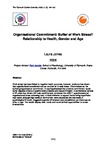Organisational Commitment: Buffer of Work Stress?
| dc.contributor.author | Jones, L. | |
| dc.date.accessioned | 2019-05-10T10:21:12Z | |
| dc.date.available | 2019-05-10T10:21:12Z | |
| dc.date.issued | 2008 | |
| dc.identifier.citation |
Jones, L. (2008) 'Organisational Commitment: Buffer of Work Stress?', The Plymouth Student Scientist, 1(2), pp. 142-185. | en_US |
| dc.identifier.issn | 1754-2383 | |
| dc.identifier.uri | http://hdl.handle.net/10026.1/13813 | |
| dc.description.abstract |
Work stress has been linked to negative health outcomes; however, evidence has shown that organisational commitment can act as a buffer to work stress. This is known as the buffering hypothesis of commitment. It was hypothesised that affective commitment would buffer negative effects of specific work stressors and reduce ill health. A convenience sample of 52 urban bus drivers (44 male and 8 female) completed the ASSET questionnaire (an organisational stress screening tool). Limited evidence to support the buffering hypothesis was found, although high levels of commitment were associated with low levels of psychological ill health. Suggestive gender differences were established, yet there was no effect of age. The results display clear trends and novel defined opportunities for stress interventions. | en_US |
| dc.language.iso | en | en_US |
| dc.publisher | University of Plymouth | |
| dc.rights | Attribution 3.0 United States | * |
| dc.rights.uri | http://creativecommons.org/licenses/by/3.0/us/ | * |
| dc.subject | health | en_US |
| dc.subject | stress | en_US |
| dc.subject | work stressors | en_US |
| dc.subject | work | en_US |
| dc.subject | psychological | en_US |
| dc.subject | ill health | en_US |
| dc.title | Organisational Commitment: Buffer of Work Stress? | en_US |
| dc.type | Article | |
| plymouth.issue | 2 | |
| plymouth.volume | 1 | |
| plymouth.journal | The Plymouth Student Scientist |



